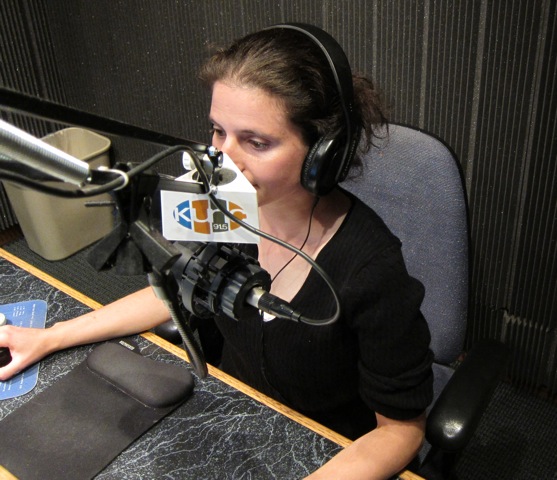20 October 2010
One-minute science
Guest post by soil ecologist Marissa Weiss, AGU’s 2010 Mass Media Fellow, on her stint as a radio reporter in Colorado. The first post of her series can be found here.
I arrived to the KUNC newsroom on Monday, September 27th. By Friday, I had my first assignment, a news spot (about one minute long) on a study of the benefits of the recent healthcare legislation to Coloradans, due the following Monday. This is definitely a “learning by doing” environment.
Days in the KUNC newsroom are full of surprises. Most days, I arrive at my desk with an idea of what I will probably do that day, and most days I follow my plan for the first hour or so. Then I get an email from the news director with an assignment or I read an exciting press release, which changes my whole plan. Suddenly, I am on the phone, trying to reach a source, to ask about five questions, to collect about ten minutes of tape. I don’t like interrupting busy people with my five questions, but I do love hearing their answers. The last question is always some variation of, “Do you have anything else you want to say?” and I almost always use some part of their answer in the final story.
As I expected, I do find keeping up with the fast pace of the newsroom challenging. Putting together a one-minute news story involves getting the interview, which could be as easy as catching someone on the phone, and less than 15 minutes later, I’ll have what I need. Or it could mean exchanging emails and phone tag, so I’ll have already invested a bunch of time before the interview even begins.
Usually, of the five questions in the interview, three are for my own background information so I can write the story, and the remaining two are the questions I hope will generate good quotes. I try hard to listen carefully so by the end of the interview I already know what the soundbites will be. Good quotes infuse the story with action or emotion.
Then I need to write the story. For each news spot, I only have to write about nine sentences, which is more challenging than one might expect. The format of the news spot is to “wrap” a quote in six of the sentences – three before, and three after. The first three sentences are for the host to read, to introduce the spot. I deliberate a lot over every word; here is one step of the process where I could stand to pick up the pace. Once written, I pass the story to the news editor or a reporter for an edit.
Then I have to record my script; I only have about 45 seconds to read all six sentences. I read and re-read the text, and the 45 seconds add up round after round, so I’m working on picking up my pace here, too. Talking in a conversational, yet authoritative tone takes a lot of practice. Using audio-editing software, I pop the interview clip into the middle of the recording of my own voice, and that becomes a news story. I have seen reporters at KUNC turn a spot around in less than two hours from idea to finished story. My news spots currently take a bit longer, and I am trying to pick up my pace. In the meanwhile, the KUNC reporters have been patient and encouraging.
I have been pleasantly surprised at how willingly and even enthusiastically scientists talk to me. Some of them are very good at communicating their science, too. I have heard interesting analogies, such as one scientist who compared a heat-exchange technology he is engineering to a baby diaper: the material soaks up heat and you extract the heat from it later, just as a baby diaper absorbs liquid and you can wring the liquid out.
While finding scientists excited about outreach has been easy, fitting a message into one minute has been hard. I often agonize over what details to include and what to leave out to convey ideas clearly, thoroughly, and quickly. My editors have helped me with this, by telling me what they understood from the way I was presenting the story, and pointing out what parts were either confusing or incomplete.
As I practice more with the one minute news spot format, I continue to reflect on the advantages and limitations of science packaged into a minute. I will soon have a chance to compare it to another news format: the four-minute news feature. More about that in a future post!
– Marissa Weiss, AGU Mass Media Fellow



 The Plainspoken Scientist is the science communication blog of AGU’s Sharing Science program. With this blog, we wish to showcase creative and effective science communication via multiple mediums and modes.
The Plainspoken Scientist is the science communication blog of AGU’s Sharing Science program. With this blog, we wish to showcase creative and effective science communication via multiple mediums and modes.
[…] One-minute science […]
[…] like a challenge! Soil-scientist-turned-radio-reporter explains how to create a 1 min story http://blog.agu.org/sciencecommunication/2010/10/20/one-minute-science/ (via […]